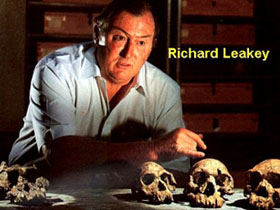 Richard Leakey's claims regarding the fossils he found by the shores of Lake Turkana in northern Kenya misled the world of paleoanthropology several times. |
As well as being an anthropologist and paleontologist, Richard Leakey is also a well known evolutionist writer. He is best known for his fossil-hunting activities, having discovered a great many fossils, particularly along the shores of Lake Turkana in Northern Kenya. Yet more than once, his suggestions regarding these fossils have misled the world of paleoanthropology.
For example, he described a fossil skull he dated at 2.8 million years old as the greatest discovery in the history of anthropology, though it was later realized that this skull's human-like face was the result of a deliberately falsified reconstruction. (See Homo rudolfensis.)
Leakey was strongly biased in favor of the theory of evolution, and never changed his attitude in the face of the evidence against it. One example of this was his statements regarding the Turkana Boy. In evolutionists' imaginary family tree, they advanced the concept of Homo erectus, meaning "upright-walking human," in order to suggest a transition from ape to man, though the skeleton of Homo erectus is identical to that of any modern man.
The best known fossil included under that classification is the Turkana Boy. Later it was determined that, contrary to evolutionist claims, the fossil belonged to a 12-year-old boy, who would have reached a height of some 1.83 meters when fully grown. In addition, shortly after the fossil was discovered, it was determined that its upright skeleton was identical to that of modern human beings.
In an article titled "Modern and Tall," Leakey described the inconsistencies between the Turkana Boy fossil and evolutionary theories:
. . . the boy from Turkana was surprisingly large compared with modern boys his age; . . . he would probably go unnoticed in a crowd today. This find combines with previous discoveries of Homo erectus to contradict a long-held idea that humans have grown larger over the millennia.17
One would also see differences: in the shape of the skull, in the degree of protrusion of the face, the robustness of the brows and so on. These differences are probably no more pronounced than we see today between the separate geographical races of modern humans. Such biological variation arises when populations are geographically separated from each other for significant lengths of time.18
17. Richard Leakey and Alan Walker, "Unearthed,"National Geographic, November 1985, p. 629.
18. Richard Leakey, The Making of Mankind, London: Sphere Books, 1981, p. 116.


